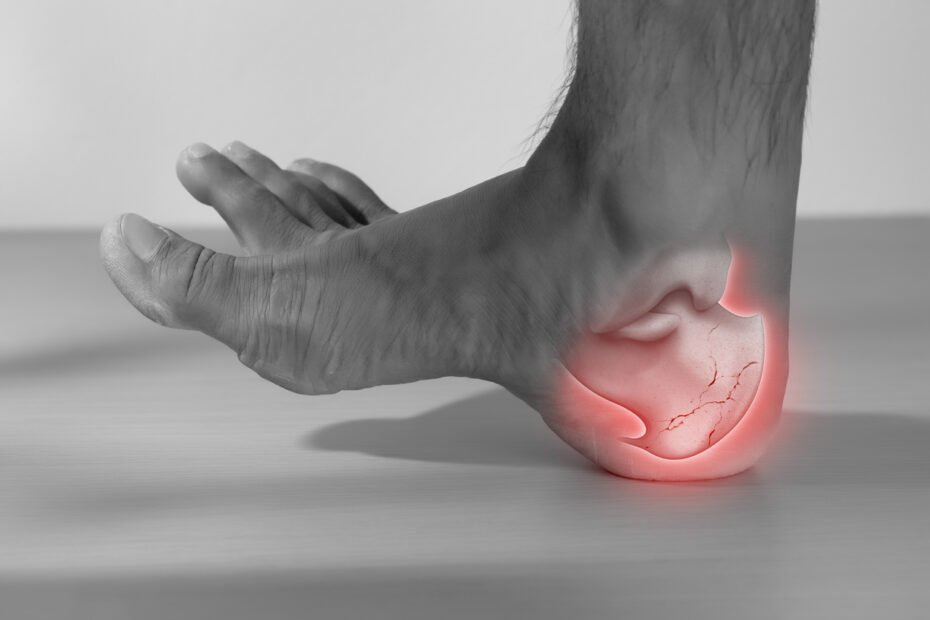Imagine starting your day with a sharp pain shooting through your heel the moment your foot hits the floor. This is a daily reality for many people suffering from plantar fasciitis, a stubborn and painful condition affecting the thick band of tissue that runs across the bottom of your foot. Each step reminds you of the discomfort, and you find yourself wondering, “Will plantar fasciitis go away on its own?”

Key Takeaways
- Plantar fasciitis is a foot condition caused by overuse and excessive strain. It’s commonly associated with repetitive or high-impact activities like running, dancing, or extended periods of walking.
- The recovery time for plantar fasciitis varies depending on factors such as severity of the condition, underlying causes, and individual health conditions.
- While some cases of plantar fasciitis can resolve naturally with rest and self-care measures, more severe and persistent cases may require professional treatment options.
- Self-care strategies such as stretching exercises, proper footwear, and rest can help alleviate symptoms and promote healing.
- Professional treatment options for plantar fasciitis include physical therapy, medications, steroid injections, and, in rare cases, surgery.
- Preventative measures such as lifestyle adjustments and regular foot care can help reduce the risk of developing plantar fasciitis.
Exploring Plantar Fasciitis: A Deep Dive into the Condition
Understanding The Condition: What Is Plantar Fasciitis?
Plantar fasciitis is a foot condition caused by overuse and excessive strain. It’s commonly associated with repetitive or high-impact activities like running, dancing, or extended periods of walking. But for some people, the shape of their foot, the type of shoes worn, or an element of obesity can also trigger this painful foot condition. Whatever the cause of overexertion, localized inflammation and small tears in the foot’s thick plantar fascia tissue can develop, which then lead to pain and stiffness.
The pain associated with this condition can vary from moderate discomfort to sharp stabbing sensations and is typically concentrated near the heel. We want you to know that finding relief from pain is possible. Having a deeper understanding of this foot condition can help you learn more about your experience with this condition and how long it may last.
Most importantly, it has the potential to lead you to find the most effective management strategy for you and your individual symptoms. In the following sections, we’ll discuss more about how long it may take for plantar fasciitis to heal and for the painful symptoms to ease, as well as the particular symptoms that should prompt you to make an appointment with your doctor.

Defining Plantar Fasciitis and Its Impact on Daily Life
Plantar fasciitis is a foot condition characterized by inflammation of the plantar fascia, a thick band of tissue that connects the heel bone to the toes. The plantar fascia acts as a shock absorber and supports the arch of the foot. When this tissue becomes strained or overused, it can lead to inflammation and pain.
The impact of plantar fasciitis on daily life can vary depending on the severity of the condition. Mild cases may cause discomfort and difficulty with certain activities, such as walking or standing for prolonged periods. However, more severe cases can significantly impact an individual’s quality of life, making it challenging to perform daily tasks and participate in physical activities.
The affected foot is typically the source of pain, with the discomfort often concentrated near the heel. The pain can range from a dull ache to a sharp, stabbing sensation. The intensity of the pain may also vary throughout the day, with some individuals experiencing more severe symptoms in the morning or after periods of rest.
Understanding the impact of plantar fasciitis on daily life can help individuals better manage their symptoms and seek appropriate treatment options. In the next section, we will explore the common causes and risk factors associated with developing plantar fasciitis.
Common Causes and Risk Factors for Developing Plantar Fasciitis
Plantar fasciitis can develop as a result of various factors, including certain risk factors. One common risk factor is having flat feet or high arches, as these foot structures can place additional stress on the plantar fascia.
Obesity is another risk factor, as the extra weight can increase the strain on the feet.
Overuse or excessive physical activity, especially activities that involve repetitive impact on the feet, can also contribute to the development of plantar fasciitis. Wearing improper footwear, such as shoes with inadequate arch support or worn-out soles, can further exacerbate the condition.
Understanding these risk factors can help individuals take preventive measures and make lifestyle adjustments to reduce the likelihood of developing plantar fasciitis.

The Healing Journey: Can Plantar Fasciitis Resolve Without Intervention?
For many sufferers, plantar fasciitis is a self-limiting condition, meaning it can indeed resolve on its own. Studies suggest that about 80% of plantar fasciitis cases improve significantly within a year with conservative treatments like rest, ice, and over-the-counter pain relievers. However, “improve” doesn’t always mean “heal,” and for some, symptoms can linger far longer without proper intervention.
The natural recovery of plantar fasciitis involves the healing response of the body to inflammation and micro-tears in the fascia. This process can be unpredictable and varies widely among individuals. Factors such as body weight, activity level, and foot mechanics play significant roles in the duration and success of recovery.
Understanding the Natural Progression of Plantar Fasciitis
The natural progression of plantar fasciitis involves a series of stages as the condition develops and evolves. In the early stages, there may be mild pain and discomfort in the affected foot, particularly near the heel bone. As the condition progresses, the plantar fascia becomes inflamed, resulting in increased pain and stiffness. Without intervention, the symptoms of this painful foot condition can persist and impact daily activities.
It is important to understand the natural progression of plantar fasciitis to recognize the need for appropriate treatment and management strategies. Seeking early intervention can help prevent further inflammation and promote a faster recovery.

Factors Influencing Natural Recovery from Plantar Fasciitis
Several factors can influence the natural recovery from this painful foot condition. The severity and duration of the condition play a significant role in the healing process. Individuals with mild cases of plantar fasciitis may experience a faster recovery compared to those with more severe or chronic cases. Additionally, certain health conditions, such as diabetes or arthritis, can hinder the natural healing process.
Wearing supportive shoes with proper arch support and cushioning can also contribute to the natural recovery from this condition by reducing pressure on the plantar fascia.
Overall, a combination of appropriate self-care strategies, lifestyle adjustments, and supportive footwear can help facilitate the natural recovery process.
Essential Self-Care Strategies for Easing Symptoms
Self-care strategies are an important aspect of managing plantar fasciitis symptoms and promoting healing. These strategies can help alleviate foot pain and discomfort, enhance mobility, and improve overall foot health. Effective stretching and strengthening exercises targeting the lower leg muscles and Achilles tendon can help reduce strain on the plantar fascia.
Wearing supportive shoes with proper arch support and cushioning can provide relief and prevent further irritation. Taking regular breaks and resting the affected foot can also help alleviate symptoms. Additionally, using night splints can help maintain a neutral foot position during sleep, reducing morning stiffness and pain.

Effective Stretching and Strengthening Exercises
Stretching and strengthening exercises play a crucial role in managing plantar fasciitis. These exercises focus on improving flexibility and strength in the affected foot, helping to alleviate symptoms and prevent future flare-ups. Stretching the plantar fascia and calf muscles can help reduce tension and promote healing.
Strengthening exercises for the lower leg muscles provide better support for the arch of the foot, reducing strain on the plantar fascia. Incorporating these exercises into your daily routine can significantly aid in the recovery process.
The Role of Footwear in Managing Plantar Fasciitis
The right footwear plays a crucial role in managing plantar fasciitis. Supportive shoes with good arch support can help alleviate pressure on the plantar fascia, reducing pain and inflammation. Avoid flat shoes or high heels that strain your foot. Cushioned soles and proper fitting shoes can aid in easing discomfort. Consider orthotic inserts for additional support.
By choosing appropriate footwear, you can significantly impact the recovery process and overall foot health.

Importance of Rest and Proper Foot Support
Rest and proper foot support play pivotal roles in managing this condition. Adequate rest aids in the healing process by reducing strain on the affected foot. Supporting your feet with suitable footwear or orthotics can alleviate pressure on the plantar fascia, promoting recovery.
Neglecting rest or wearing unsupportive shoes may exacerbate symptoms, prolonging the healing time. Remember, a balance of rest and proper foot support is essential for addressing plantar fasciitis effectively and improving overall foot health.
Professional Treatment Options: Beyond Home Remedies
Plantar fasciitis cases may require professional treatment options beyond home remedies. If symptoms persist, seeking medical advice is crucial. Medical interventions such as physical therapy, steroid injections, or even surgical intervention could be recommended based on individual cases.
A podiatrist might suggest night splints or custom orthotics for effective management. Professional guidance can significantly impact the recovery time and overall quality of life for individuals dealing with plantar fasciitis. Treatment options offer a tailored approach to address specific needs and promote healing.

When to Seek Medical Advice for Plantar Fasciitis
It is advisable to seek medical advice for plantar fasciitis if you experience persistent heel pain that does not improve with self-care measures. If the pain intensifies, impacts your daily activities, or if you notice swelling, you should consult a healthcare professional promptly. Additionally, if you have diabetes or circulation issues, it is crucial to seek medical guidance, as these conditions can complicate plantar fasciitis.
Remember, early intervention can prevent further complications and expedite the healing process.
Overview of Medical Interventions and Their Efficacy
Surgical intervention is considered a last resort when other treatments have failed. Procedures may involve releasing part of the plantar fascia from the heel bone to relieve tension. Steroid injections can reduce inflammation and provide temporary relief. However, these injections are limited in frequency due to potential side effects.
Physical therapy is often recommended to address underlying musculoskeletal issues contributing to the condition. Podiatrists may suggest custom orthotics to support the foot and correct biomechanical imbalances.
Preventative Measures: Stopping Plantar Fasciitis Before It Starts
Lifestyle adjustments and regular foot care are pivotal in preventing this painful foot condition. Maintaining a healthy weight reduces stress on your feet, while proper footwear offers essential support. Stretching exercises for lower leg muscles and the Achilles tendon can help prevent overuse injuries.
Avoid prolonged periods on hard surfaces and consider orthotic inserts if you have flat feet. By prioritizing foot health and being mindful of risk factors, you can significantly lower the chances of developing plantar fasciitis.

Lifestyle Adjustments to Lower the Risk of Plantar Fasciitis
Optimizing your lifestyle can significantly diminish the risk of this painful foot condition. Maintaining a healthy weight reduces pressure on your feet, mitigating strain on the plantar fascia.
Choosing supportive footwear with ample cushioning and arch support aids in shock absorption and reduces stress on the heels.
Regularly stretching and strengthening lower leg muscles helps maintain flexibility and stability.
Avoiding prolonged periods on hard surfaces and incorporating rest breaks during standing or walking activities can prevent overuse injuries.
Engaging in physical activities that promote foot health and avoiding sudden increases in intensity can safeguard against developing this painful condition.
Regular Foot Care Practices for Healthy Feet
Regular foot care practices are crucial for maintaining healthy feet, especially when dealing with conditions like plantar fasciitis. This involves daily inspection of the feet for any abnormalities, washing them regularly, keeping the feet dry, and moisturizing to prevent dryness and cracking. Additionally, wearing proper footwear that provides adequate support and cushioning is essential.
Regularly trimming nails straight across and avoiding tight shoes can also help prevent discomfort.
Simple activities like foot stretching exercises can promote flexibility and reduce the risk of foot-related issues.

How long does it typically take for plantar fasciitis to go away?
Recovery time for plantar fasciitis varies but often improves within a few months with proper care. Factors like severity and adherence to treatment influence the duration. Consistent self-care, rest, and medical guidance aid in resolving symptoms faster.
Can exercises completely cure plantar fasciitis?
Regular exercises can significantly help in alleviating the symptoms and promoting healing. While exercises are beneficial, a comprehensive treatment approach involving various strategies is often recommended for complete resolution.
Is it possible for plantar fasciitis to come back after healing?
Yes, plantar fasciitis can recur after healing, especially if underlying causes are not addressed. Factors like overuse, improper footwear, and poor biomechanics can contribute to its return. Regular stretching, proper support, and addressing risk factors can help prevent its recurrence.
What are the signs that my plantar fasciitis is improving?
Signs of improving this foot condition includes reduced pain in the heel, improved mobility, less stiffness in the foot upon waking, and decreased swelling. Gradual return to normal activities without discomfort is also a positive indicator of recovery.

Conclusion
Dealing with plantar fasciitis is undeniably challenging, but it’s important to remember that relief is possible with the right approach. While the condition may improve on its own, taking proactive steps towards recovery, guided by credible sources and professional advice, will significantly enhance the likelihood of a pain-free life.
So, if you find yourself struggling with persistent heel pain, why not visit theheelgp.com and explore the treatment options that could pave the way to your recovery? As you weigh your options, consider this: what steps can you take today to move towards a pain-free tomorrow?
I hope you found this blog helpful and please feel free to comment and share.
Thanks for reading!
 | Tracy J. Founder, The heel GP |
